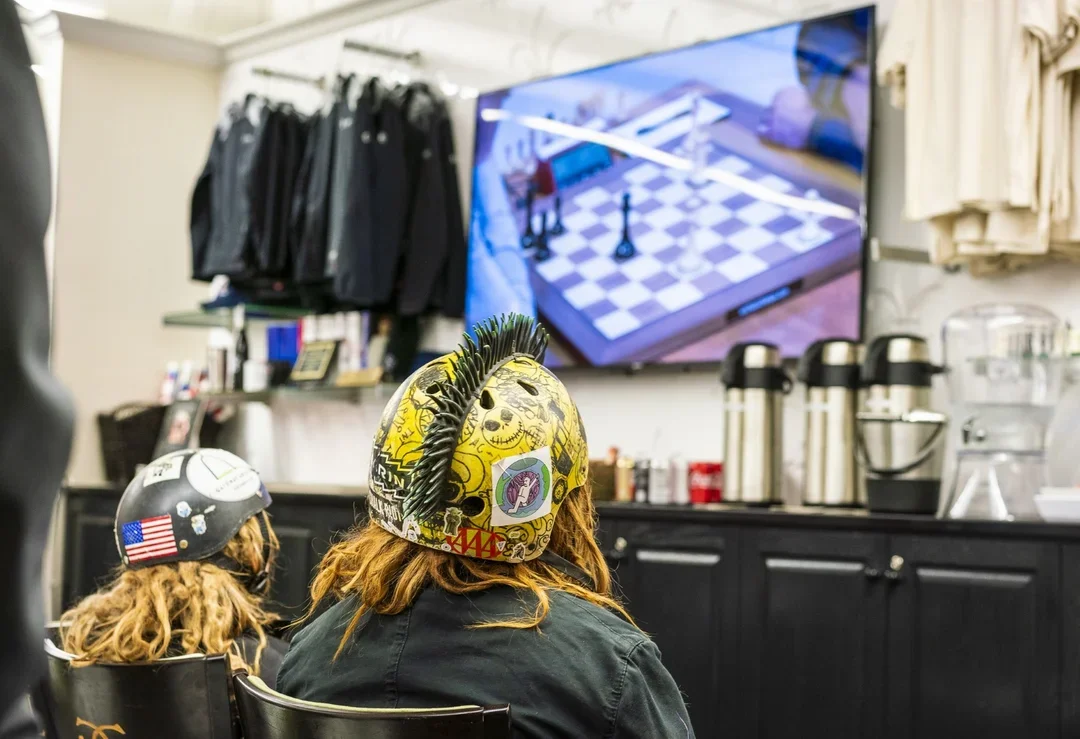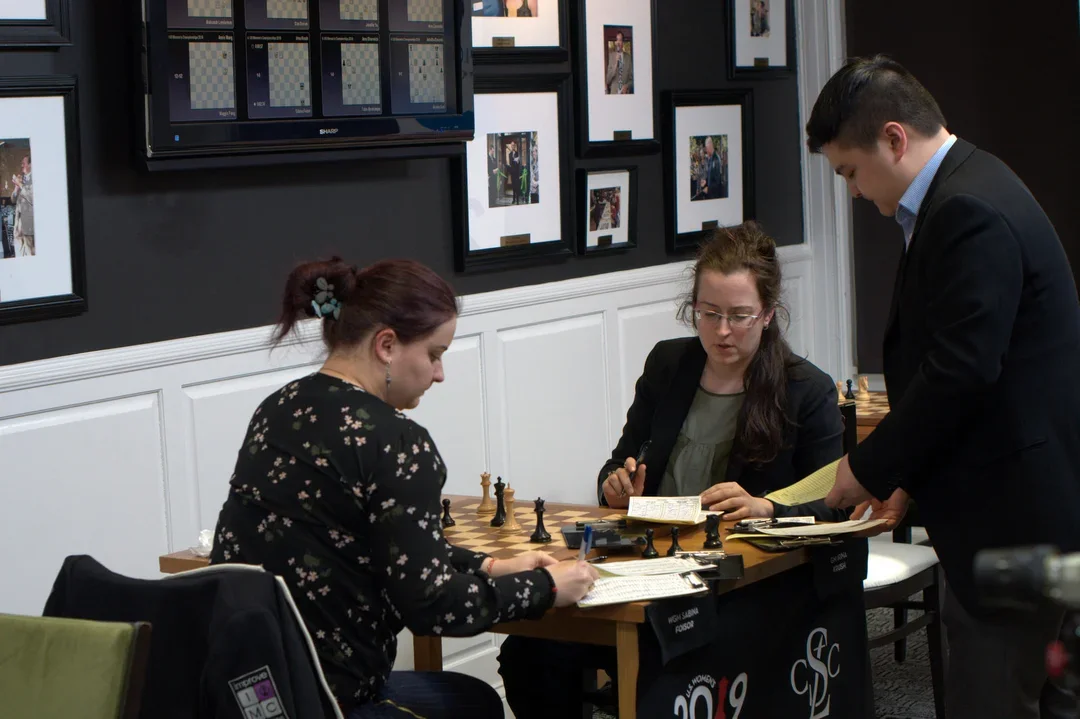As I look back on my time in Saint Louis attending the 2019 U.S. Championships, there are moments and images that stick with me. One of them is the experience of watching the final moves of the Round 4 encounter between Sabina Foisor and Irina Krush. In that game, you may recall, Foisor struggled against both a ticking clock and a determined Krush to finally clinch a theoretically won Queen and Pawn versus Queen endgame.
Part of what made this game so memorable was seeing it ‘live’ at the Saint Louis Chess Club. The assembled players and fans, including Foisor’s fiance, Elshan Moradiabadi, were rapt as the announcing team of Yasser Seirawan, Jennifer Shahade, and Maurice Ashley worked through the immense thickets of checks and counter-checks, showing viewers how Foisor could win and how Krush might (if Foisor stumbled) eke out the draw.
https://youtu.be/MVYJWTmTm8s
After Foisor played her 146th move and Krush resigned, there was a cheer downstairs and a sense of palpable relief. It was nothing against Krush, of course, a legendary and beloved figure in American chess; rather, I think it was simply that the tension of the situation was broken, that the back-and-forth had ended, and that our attention could leave those taut positions and return to more mundane concerns.
While watching Jen, Yaz, and Maurice do their work, I realized that, were I in Krush’s shoes, I would have no idea as to how to best defend. Queen and Pawn vs. Queen endings are notoriously tricky, with complex lines of checks and counter-checks to consider. I knew from reading Dvoretsky that one game – Botvinnik-Minev, from the 1954 Olympiad – was considered paradigmatic, but what did that game really teach us, and how did it bear on what was unfolding in front of me?
This week’s Workout revolves around those questions. Can you play like Sabina Foisor and win her ending against Irina Krush? Can you win it faster than she did? In what follows, I’ll give you the position, followed by the generally accepted theory and a few examples. Then it’s up to you. Play it out against a friend or against the computer – I suggest you use the Tarrasch Chess GUI (a free download) for this purpose if you don’t have commercial software handy – and see how you do.
The Key Position:
Foisor-Krush, after Black’s 58th move.
The FEN (to paste into your playing program): 1Q6/8/8/q7/8/4k3/1KP5/8 w - - 0 59
Theory:
Queen and Pawn vs. Queen endings are drawn unless (a) attacking side has a bishop or central pawn and (b) the pawn is on the 7th rank and supported by the king. If the defender can get in front of the pawn, the ending should be drawn regardless of which type of pawn it is. Otherwise, the defender should place the king as far from the pawn as possible, in a corner opposite from the queening square.
Defensive ideas include checking to try and win the pawn, or when checks run out, pinning the pawn to the king or queen so that it cannot move forward.
The attacker should strive to put her king on the same (or adjacent) line as the defending king to maximize the chances of a counter-check or cross-check, a tactic used to escape endless checks by the defender and trade queens. The queen should also try to stay centralized.
Bishop pawns (c/f) give the best winning chances, followed by central pawns (d/e). Knight pawns (b/g) give decent drawing chances, while rook pawns (a/h) are theoretical draws. In all cases the defense is very difficult, practically speaking, so player with the pawn should play for the win, even if the position is ‘theoretically’ drawn.
Most effective defensive zones:
Rook pawns (a and h): King in front or in opposite corner.
Knight pawns (b and g): King in front or in opposite corner.
Bishop pawns (c and f): Only the king in front of the pawn gives drawing chances.
Central pawns (d and e): King in front or, per Nunn, the short-side ‘queening’ corner. This would be h8 if the attacker has an e-pawn, for instance.
Examples:
Botvinnik-Minev was critical for the development of the theory of this endgame.
[pgn]
[Event "Olympiad-11 Final A"]
[Site "Amsterdam"]
[Date "1954.09.17"]
[White "Botvinnik, Mikhail Moisevich"]
[Black "Minev, Nikolay Nikolaev"]
[Result "1-0"]
[ECO "D47"]
[Annotator "Hartmann,John"]
[SetUp "1"]
[FEN "8/8/4Q3/k6K/8/6P1/8/q7 b - - 0 57"]
[PlyCount "68"]
57... Qh8+ 58. Kg6 Qc3 59. g4 Qd2 60. g5 Qd4 61. Qf5+ Ka4 62. Kh5 Qh8+
63. Kg4 Qh1 64. Qf4+ Ka5 65. Qe5+ Ka4 66. g6 Qd1+ 67. Kg5 Qd8+ 68. Kf5 Qc8+ 69.
Kf4 Qc1+ 70. Qe3 Qc7+ 71. Qe5 Qc1+ 72. Kf5 Qc8+ 73. Kg5 Qd8+ {[#]} 74. Qf6 $1 {
"[I]f the White king is on the same rank as Black's or next to it, then the
enemy queen checks must eventually become exhausted, since White will have a
queen interposition which also offers check!" (Botvinnik)} (74. Kh6 Qh4+ 75.
Kg7 Qh3 {(Botvinnik) and "White has a much harder time of it." This is true in
a practical sense, but the tablebases tell us that White has multiple wins
here. Primary is} (75... Ka3 $1 {is the only move that draws. The king has to
head to the diametrically opposing corner.}) 76. Qf4+ Ka3 77. Kf6 Qc3+ 78. Kf7
{and White will win.}) (74. Kf5 {is more precise (Dvoretsky) for difficult
technical reasons.}) 74... Qd5+ 75. Qf5 Qd8+ 76. Kh5 Qe8 (76... Qh8+ 77. Kg4
Qg7 78. Qf7 $1 {shows the key idea:} Qd4+ $2 (78... Qc3 79. g7) 79. Qf4 $18)
77. Qf4+ $2 {Today we see that this is an error. Why? It practically forces
the defending king towards its best defensive position - the diametrically
opposing corner.} ({Dvoretsky gives the toughest defense for Black:} 77. Kg4 $1
Qe2+ 78. Kf4 Qd2+ 79. Ke5 Qb2+ 80. Ke6 Qb6+ 81. Ke7 Qb4+ 82. Kf7 Qb7+ 83. Kf6
Qb6+ 84. Qe6 {and White still wins, although it's practically challenging.})
77... Ka5 $2 (77... Ka3 $1 $11 {Heading for the correct defensive zone.}) 78.
Qd2+ Ka4 79. Qd4+ Ka5 80. Kg5 Qe7+ 81. Kf5 Qf8+ 82. Ke4 Qh6 83. Qe5+ Ka4 84. g7
Qh1+ 85. Kd4 Qd1+ 86. Kc5 Qc1+ 87. Kd6 (87. Kd5 {still wins, but Botvinnik
thought it inferior as it gummed up the a2-g8 diagonal.}) 87... Qd2+ 88. Ke6
Qa2+ 89. Qd5 Qe2+ 90. Kd6 Qh2+ 91. Kc5 $1 {White will cross-check no matter
how Black checks, and if Black doesn't, the pawn promotes. Outstanding
analysis and play by Botvinnik.} 1-0
[/pgn]
Another example of a win for the attacking side, this time with the c-pawn (as in Foisor-Krush).
[pgn]
[Event "FSFMA July 2014"]
[Site "Budapest HUN"]
[Date "2014.07.14"]
[White "Dombi, R."]
[Black "Knudsen, M."]
[Result "1-0"]
[ECO "B10"]
[WhiteElo "2028"]
[BlackElo "2021"]
[Annotator "Hartmann,John"]
[SetUp "1"]
[FEN "8/8/8/8/3Q4/1KP3k1/5q2/8 b - - 0 63"]
63... Qf7+ 64. c4 Qb7+ 65. Kc3 Kh2 66. c5 Qf3+ 67. Kb4 Qb7+ 68. Kc4 Qf7+
69. Qd5 Qf1+ 70. Kd4 Qf4+ 71. Qe4 Qd2+ 72. Ke5 Qg5+ 73. Qf5 Qe3+ 74. Kd6 Qh6+
75. Qe6 Qf8+ 76. Qe7 Qh6+ 77. Kc7 Kh1 78. c6 Qf4+ 79. Kc8 Qf5+ 80. Kb8 Qf4+ 81.
c7 {[#]} Qg3 82. Kb7 Qb3+ 83. Kc6 Qa4+ 84. Kd6 Qd4+ 85. Ke6 Qc4+ 86. Kf5 Qf1+
87. Kg6 Qd3+ 88. Kg7 Qc3+ 89. Kg8 Qg3+ 90. Qg7 Qb3+ 91. Kh8 Qb7 92. Qh7+ Kg1
93. Qg8+ Kf1 94. c8=Q Qb2+ 95. Qg7 Qh2+ 96. Kg8 Qa2+ 97. Qf7+ 1-0
[/pgn]
This ending with the rook pawn is theoretically drawn. Here’s what that might look like in practice.
[pgn] [Event "ch-RUS"] [Site "Moscow RUS"] [Date "2008.10.06"] [White "Riazantsev, A."] [Black "Vitiugov, N."] [Result "1/2-1/2"] [ECO "D43"] [WhiteElo "2656"] [BlackElo "2638"] [Annotator "Hartmann,John"] [SetUp "1"] [FEN "8/q7/8/4Q1K1/7P/8/8/5k2 w - - 0 66"] [PlyCount "125"] 66. h5 Qg1+ 67. Kf5 Qg8 68. h6 Qh7+ 69. Kg5 Qg8+ 70. Kh4 Qc4+ 71. Kh3 Qb3+ 72. Kh4 Qc4+ 73. Kh5 Qf7+ 74. Kg4 Qg8+ 75. Qg5 Qh8 76. Qf5+ Ke1 77. h7 Kd1 78. Qd5+ Kc1 79. Qg8 Qd4+ 80. Kh5 Qd1+ 81. Qg4 Qh1+ 82. Kg6 Qc6+ 83. Kg5 Qd5+ 84. Qf5 Qg2+ 85. Kh6 Qc6+ 86. Kh5 Qh1+ 87. Kg6 Qc6+ 88. Qf6 Qe4+ 89. Kh6 Qh1+ 90. Kg7 Qb7+ 91. Kg6 Qe4+ 92. Qf5 Qc6+ 93. Kg5 Qg2+ 94. Kh4 Qh2+ 95. Kg5 Qg2+ 96. Kf6 Qc6+ 97. Qe6 Qf3+ 98. Ke7 Qb7+ 99. Qd7 Qb4+ 100. Ke8 Qb8+ 101. Ke7 Qe5+ 102. Kd8 Qh8+ 103. Kc7 Qe5+ 104. Kb7 Qb2+ 105. Ka6 Qa3+ 106. Kb6 Qb2+ 107. Qb5 Qh8 108. Qc4+ Kb1 109. Qc7 Qd4+ 110. Kb7 Qe4+ 111. Kb8 Qe8+ 112. Qc8 Qe5+ 113. Ka7 Qd4+ 114. Ka8 Qa4+ 115. Kb8 Qf4+ 116. Qc7 Qf8+ 117. Kb7 Qf3+ 118. Ka6 Qd3+ 119. Ka7 Qa3+ 120. Kb8 Qf8+ 121. Qc8 Qf4+ 122. Ka7 Qd4+ 123. Ka8 Qa4+ 124. Kb8 Qf4+ 125. Qc7 Qf8+ 126. Ka7 Qa3+ 127. Kb7 Qf3+ 128. Kc8 1/2-1/2 [/pgn]The knight’s pawn is theoretically winning, but draws are not uncommon. Karsten Müller uses an excellent version of this ending in Chess Endgames For Kids to illustrate how the draw can be held.
[pgn]
[Event "Politiken Cup"]
[Site "Helsingor DEN"]
[Date "2009.07.24"]
[White "Negi, P."]
[Black "Postny, E."]
[Result "1/2-1/2"]
[ECO "B19"]
[WhiteElo "2590"]
[BlackElo "2647"]
[Annotator "Hartmann,John"]
[SetUp "1"]
[FEN "Q7/8/1q6/8/1PK5/8/4k3/8 w - - 0 63"]
[PlyCount "141"]
63. Qe8+ Kf1 64. b5 Qc7+ 65. Kd5 Qb7+ 66. Qc6 Qf7+ 67. Kd6 Qf4+ 68. Kd7
Qf7+ 69. Kc8 Qf8+ 70. Kb7 Qe7+ 71. Qc7 Qe4+ 72. Ka6 Qa4+ 73. Qa5 Qc4 {Having
run out of checks, Black pins the pawn and prepares to move his king to the
correct defensive position - the corner furthest from the aspiring pawn.} 74.
Qa1+ Kg2 75. Qb2+ Kh1 76. Qh8+ Kg1 77. Qg7+ Kh1 78. Qb7+ Kh2 79. Qc6 Qa2+ 80.
Kb7 {Staying on a dark square to minimize the chances of cross-checks. (The
Black queen is on a light square.)} Kg1 81. Qc1+ Kf2 82. Qc5+ Kf1 83. b6 Qg2+
84. Ka6 Qa8+ 85. Kb5 Qe8+ 86. Ka5 Qe1+ 87. Ka6 Qa1+ 88. Qa5 Qf6 89. Qb5+ Kg1
90. Qc5+ Kh1 91. Ka7 Qa1+ 92. Kb7 Qg7+ 93. Qc7 Qf8 94. Qd7 Qf2 95. Qd5+ Kg1 96.
Qg5+ Kh1 97. Kc6 Qc2+ 98. Kd6 Qh2+ 99. Qe5 Qh6+ 100. Kc5 {Negi tries to follow
Botvinnik's plan from the Minev game - bring the kings closer together to
increase the chances of a cross-check. As Postny has put his king in the
correct defensive zone, this should not work.} Qc1+ 101. Kd5 Qd2+ 102. Qd4 Qg5+
103. Kc4 Qc1+ 104. Qc3 Qf1+ 105. Kb4 Qb1+ 106. Qb3 Qe1+ 107. Kb5 Qe5+ 108. Ka6
Qa1+ 109. Kb7 Qg7+ 110. Kc6 Qf6+ 111. Kc5 Qe7+ 112. Kd4 Qf6+ 113. Kd3 Qf5+ 114.
Kc3 Qe5+ 115. Kb4 Qe1+ 116. Qc3 Qb1+ 117. Ka5 Qa2+ 118. Kb5 Qd5+ 119. Qc5 Qd3+
120. Kc6 Qg6+ 121. Kb7 Qf7+ 122. Ka6 Qa2+ 123. Qa5 Qe2+ 124. Ka7 {[#]} Qf2 {
Pinning the pawn once more.} 125. Qd5+ Kg1 126. Kb7 Qf8 127. Qd4+ Kh1 128. Qe4+
Kg1 129. Qe3+ Kh1 130. Ka7 Qf2 $1 {Offering the queen for stalemate.} 131. Qe4+
Kg1 132. Kb7 Qf7+ 133. Kc6 1/2-1/2
[/pgn]
Armed with this knowledge, and hopefully having tried to win the ending on your own, compare your results with the game continuation in Foisor-Krush.
[pgn]
[Event "59th ch-USA w 2019"]
[Site "Saint Louis USA"]
[Date "2019.03.23"]
[White "Foisor, Sabina-Francesca"]
[Black "Krush, Irina"]
[Result "1-0"]
[ECO "B62"]
[WhiteElo "2276"]
[BlackElo "2451"]
[Annotator "Hartmann,John"]
[SetUp "1"]
[FEN "1Q6/8/8/q7/8/4k3/1KP5/8 w - - 0 59"]
[PlyCount "175"]
59. Qg3+ Ke2 60. Qd3+ Kf2 61. Qd4+ Kg2 62. c3 Kh1 63. c4 Qb4+ 64. Kc2
Qa4+ 65. Kd2 Qb4+ 66. Qc3 Qd6+ 67. Kc2 Qg6+ 68. Qd3 Qg2+ 69. Kc3 Qg7+ 70. Qd4
Qg3+ 71. Kb4 Qb8+ 72. Ka5 Qa8+ 73. Kb5 Qe8+ 74. Kb4 Qb8+ 75. Kc3 Qg3+ 76. Kc2
Qg2+ 77. Kc1 Qg5+ 78. Qd2 Qe7 79. Qd5+ Kg1 80. c5 Qe3+ 81. Kd1 Qc3 82. Qg5+ Kh1
83. Qh5+ Kg1 84. Qg4+ Kh2 85. Qf4+ Kh3 86. Qf5+ Kg3 87. Qc2 $2 (87. Qd5 Qa1+
88. Kc2 Qa5 89. Qd6+ Kg2 90. c6 {etc}) 87... Qd4+ 88. Kc1 Qf4+ $2 (88... Kf4 $1
{(rushing the king to attack the pawn)} 89. c6 Qg1+ 90. Kb2 Qb6+ 91. Ka3 Ke5 {
theoretically drawn}) 89. Kb2 Qc7 90. c6 Kh4 91. Qc4+ Kg3 92. Kb3 Kh2 93. Qc2+
Kh1 94. Qd1+ Kh2 95. Qd7 Qb6+ 96. Kc4 Qa6+ 97. Kc5 Qa5+ 98. Kd6 Qa3+ 99. Kc7
Qa7+ 100. Kd8 Qb8+ 101. Ke7 Qe5+ 102. Qe6 Qc7+ 103. Ke8 Kh1 104. Kf8 Qd8+ 105.
Kf7 Qc7+ 106. Kg6 Qg3+ 107. Kh7 Qd3+ 108. Qg6 Qc4 109. Qh6+ Kg1 110. Qd6 Kh1
111. c7 Qc2+ 112. Kg7 Qc3+ 113. Kf7 Qc4+ 114. Ke7 Qe4+ 115. Qe6 Qh7+ 116. Kd6
Qh2+ 117. Kc6 Qc2+ 118. Kb7 Qb2+ 119. Qb6 Qg7 120. Ka8 (120. Kb8 Qg3 121. Ka7
Qa3+ 122. Kb7 Qe7 (122... Qf3+ $2 123. Qc6) 123. Qh6+ {A key idea - gaining
tempi to improve the queen and prepare Kc6.} Kg2 124. Qg6+ Kh1 125. Kc6 Qf8 $8
126. Kd7) 120... Qf8+ 121. Ka7 Qa3+ 122. Kb8 (122. Kb7 Qe7 123. Qh6+ {similar
to the above}) 122... Qg3 123. Qb1+ Kh2 124. Qb2+ Kh1 125. Kb7 Qf3+ 126. Ka7
Qe3+ 127. Ka6 Qd3+ 128. Qb5 Qa3+ 129. Kb6 Qe3+ 130. Kb7 Qe7 131. Qd5+ Kh2 132.
Qd4 Qf7 133. Qd3 Qe7 134. Qd2+ Kh1 135. Qh6+ Kg1 136. Qf4 Qd7 137. Qg5+ Kh1
138. Qh6+ Kg1 139. Kb8 Qb5+ 140. Ka7 Qa5+ 141. Kb7 Qd5+ 142. Qc6 Qf7 143. Ka8
Qa2+ 144. Kb8 Qb3+ 145. Qb7 Qg3 146. Ka8 1-0
[/pgn]
References:
Averbakh, Yuri. Comprehensive Chess Endings: Volume 3, Queen and Pawn Endings, Queen Against Rook Endings, Queen Against Minor Piece Endings. Oxford: Pergamon Press, 1986. 29-70.
Botvinnik, Mikhail. Botvinnik on the Endgame. Coraopolis, Penn: Chess Enterprises, 1985. 37-39.
Dvoretsky, Mark. Dvoretsky’s Endgame Manual. 4th edition. Milford: Russell Enterprises, 2015. 266-268.
Fine, Reuben, and Pal Benko. Basic Chess Endings. Revised edition. New York: Random House, 2004. 526-530.
Mednis, Edmar. Questions and Answers on Practical Endgame Play. Coraopolis: Chess Enterprises, 1987. 126-128
Müller, Karsten. Chess Endgames for Kids: Featuring 50 Endgame Lessons. London: Gambit, 2015. 102-105.
Müller, Karsten, and Frank Lamprecht. Fundamental Chess Endings. London: Gambit, 2001. 316-320.
Nunn, John. Nunn’s Chess Endings. Volume 1. London: Gambit, 2010.
Categories
Archives
- January 2026 (8)
- December 2025 (27)
- November 2025 (29)
- October 2025 (39)
- September 2025 (27)
- August 2025 (29)
- July 2025 (43)
- June 2025 (25)
- May 2025 (24)
- April 2025 (29)
- March 2025 (29)
- February 2025 (20)
- January 2025 (24)
- December 2024 (34)
- November 2024 (18)
- October 2024 (35)
- September 2024 (23)
- August 2024 (27)
- July 2024 (44)
- June 2024 (27)
- May 2024 (31)
- April 2024 (51)
- March 2024 (34)
- February 2024 (25)
- January 2024 (26)
- December 2023 (29)
- November 2023 (26)
- October 2023 (37)
- September 2023 (27)
- August 2023 (37)
- July 2023 (47)
- June 2023 (33)
- May 2023 (37)
- April 2023 (45)
- March 2023 (37)
- February 2023 (28)
- January 2023 (31)
- December 2022 (23)
- November 2022 (32)
- October 2022 (31)
- September 2022 (19)
- August 2022 (39)
- July 2022 (32)
- June 2022 (35)
- May 2022 (21)
- April 2022 (31)
- March 2022 (33)
- February 2022 (21)
- January 2022 (27)
- December 2021 (36)
- November 2021 (34)
- October 2021 (25)
- September 2021 (25)
- August 2021 (41)
- July 2021 (36)
- June 2021 (29)
- May 2021 (29)
- April 2021 (31)
- March 2021 (33)
- February 2021 (28)
- January 2021 (29)
- December 2020 (38)
- November 2020 (40)
- October 2020 (41)
- September 2020 (35)
- August 2020 (38)
- July 2020 (36)
- June 2020 (46)
- May 2020 (42)
- April 2020 (37)
- March 2020 (60)
- February 2020 (38)
- January 2020 (45)
- December 2019 (34)
- November 2019 (35)
- October 2019 (42)
- September 2019 (45)
- August 2019 (56)
- July 2019 (44)
- June 2019 (35)
- May 2019 (40)
- April 2019 (48)
- March 2019 (61)
- February 2019 (39)
- January 2019 (30)
- December 2018 (29)
- November 2018 (51)
- October 2018 (45)
- September 2018 (29)
- August 2018 (49)
- July 2018 (35)
- June 2018 (31)
- May 2018 (39)
- April 2018 (31)
- March 2018 (26)
- February 2018 (33)
- January 2018 (30)
- December 2017 (26)
- November 2017 (24)
- October 2017 (30)
- September 2017 (30)
- August 2017 (31)
- July 2017 (28)
- June 2017 (32)
- May 2017 (26)
- April 2017 (37)
- March 2017 (28)
- February 2017 (30)
- January 2017 (27)
- December 2016 (29)
- November 2016 (24)
- October 2016 (32)
- September 2016 (31)
- August 2016 (27)
- July 2016 (24)
- June 2016 (26)
- May 2016 (19)
- April 2016 (30)
- March 2016 (36)
- February 2016 (28)
- January 2016 (32)
- December 2015 (26)
- November 2015 (23)
- October 2015 (16)
- September 2015 (28)
- August 2015 (28)
- July 2015 (6)
- June 2015 (1)
- May 2015 (2)
- April 2015 (1)
- February 2015 (3)
- January 2015 (1)
- December 2014 (1)
- July 2010 (1)
- October 1991 (1)
- August 1989 (1)
- January 1988 (1)
- December 1983 (1)


















